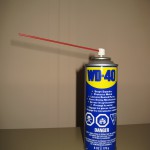In North America, WD-40 is a household name. Nearly everyone has one of the small blue and yellow canisters under their kitchen sink or on a workshop bench in the basement or garage.
Marketed as “The Can with 1,000 Uses,” people often use WD-40 to stop squeaks, prevent rust and remove dirt from hard to reach places. In our house it’s the go-to can for fixing squeaky door hinges and loosening nuts and bolts.
A visit to www.wd40.com reveals other possible applications:
- cleaning and lubricating guitar strings
- erasing crayon artwork from walls
- untangling jewellery chains
- keeping flies off cows
- cleaning bowling balls
- getting peanut butter out of shoestrings
- preventing bathroom mirrors from fogging up
- giving a floor that “just waxed” sheen without leaving it slippery
(Just so you know, the 2,000+ list of potential uses found on the WD-40 website has been compiled from public submissions and in no way implies endorsement by WD-40 or me.)
 The super spray was developed in 1953 by California resident Norm Larsen. As founder of the Rocket Chemical Company, he was looking for a way to repel water and prevent corrosion. His invention was first used to prevent rust and corrosion on the outer skin of the Atlas missile and was available on store shelves by 1958.
The super spray was developed in 1953 by California resident Norm Larsen. As founder of the Rocket Chemical Company, he was looking for a way to repel water and prevent corrosion. His invention was first used to prevent rust and corrosion on the outer skin of the Atlas missile and was available on store shelves by 1958.
But the really interesting thing about WD-40 is its name. The WD stands for water displacement. And the 40 indicates that the formula was Larsen’s 40th attempt. That’s right. He reworked and tested his idea 40 times before creating something marketable.
And what does this have to do with writing? Lots, actually and I’m not talking about lubricating your squeaky office chair.
We’ve all heard about famous authors who received multiple rejections before getting published. Here are some figures I found on the Internet:
- J.K. Rowling’s manuscript was rejected 12 times before her first Harry Potter book was published
- The Diary of Anne Frank received 15 rejections
- John Grisham’s A Time to Kill was turned down by 16 publishers
- Williams Golding’s classic, The Lord of the Flies, collected 20 rejection slips
- Margaret Mitchell’s Gone with the Wind received 38 rejections
- Jack Canfield’s Chicken Soup for the Soul received a whopping 134 rejections
Just like Larson, theses authors didn’t give up until they succeeded. They kept polishing and reviewing their work and sending it out until a publisher said “yes.”
Everyone struggles with creative endeavors from time to time. Getting something right isn’t always easy. It usually requires hefty amounts of commitment, time and energy. And sometimes it seems like the most sensible thing to do is give up.
That’s when a little inspiration can help a lot. Not everyone has a copy of Harry Potter and the Philosopher’s Stone on hand to remind them of what J.K. Rowling went through before she achieved her goal. But most folks have one of those little blue and yellow cans in the house or garage.
So, when in doubt, get the WD-40 out. If Larson could do it, maybe you can too.

Interesting to read about all of those famous rejections, and encouraging as well. Thanks!